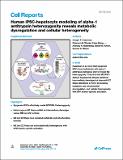Por favor, use este identificador para citar o enlazar a este item:
http://hdl.handle.net/10261/295514COMPARTIR / EXPORTAR:
 SHARE SHARE
 CORE
BASE CORE
BASE
|
|
| Visualizar otros formatos: MARC | Dublin Core | RDF | ORE | MODS | METS | DIDL | DATACITE | |

| Título: | Human iPSC-hepatocyte modeling of alpha-1 antitrypsin heterozygosity reveals metabolic dysregulation and cellular heterogeneity |
Autor: | Kaserman, Joseph E.; Werder, Rhiannon B.; Wang, Feiya; Matte, Taylor; Higgins, Michelle I.; Dodge, Mark; Lindstrom-Vautrin, Jonathan; Bawa, Pushpinder; Hinds, Anne; Bullitt, Esther; Caballero, Ignacio S.; Shi, Xu; Gerszten, Robert E.; Brunetti-Pierri, Nicola; Liesa, Marc CSIC ORCID ; Villacorta-Martin, Carlos; Hollenberg, Anthony N.; Kotton, Darrell N.; Wilson, Andrew A. | Palabras clave: | Induced pluripotent stem cells iPSC-derived hepatocytes Alpha-1 antitrypsin deficiency ER stress Proteostasis Unfolded protein response Metabolic dysregulation Mitochondrial dysfunction Liver fibrosis Cellular heterogeneity |
Fecha de publicación: | 6-dic-2022 | Editor: | Cell Press | Citación: | Cell Reports 41(10): 111775 (2022) | Resumen: | Individuals homozygous for the “Z” mutation in alpha-1 antitrypsin deficiency are known to be at increased risk for liver disease. It has also become clear that some degree of risk is similarly conferred by the heterozygous state. A lack of model systems that recapitulate heterozygosity in human hepatocytes has limited the ability to study the impact of a single Z alpha-1 antitrypsin (ZAAT) allele on hepatocyte biology. Here, we describe the derivation of syngeneic induced pluripotent stem cells (iPSCs) engineered to determine the effects of ZAAT heterozygosity in iPSC-hepatocytes (iHeps). We find that heterozygous MZ iHeps exhibit an intermediate disease phenotype and share with ZZ iHeps alterations in AAT protein processing and downstream perturbations including altered endoplasmic reticulum (ER) and mitochondrial morphology, reduced mitochondrial respiration, and branch-specific activation of the unfolded protein response in cell subpopulations. Our model of MZ heterozygosity thus provides evidence that a single Z allele is sufficient to disrupt hepatocyte homeostatic function. | Versión del editor: | http://dx.doi.org/10.1016/j.celrep.2022.111775 | URI: | http://hdl.handle.net/10261/295514 | DOI: | 10.1016/j.celrep.2022.111775 | Identificadores: | doi: 10.1016/j.celrep.2022.111775 issn: 2211-1247 |
| Aparece en las colecciones: | (IBMB) Artículos |
Ficheros en este ítem:
| Fichero | Descripción | Tamaño | Formato | |
|---|---|---|---|---|
| Human iPSC-hepatocyte modeling of alpha-1_Kaserman_PV_Art2022.pdf | 9,21 MB | Adobe PDF |  Visualizar/Abrir |
CORE Recommender
SCOPUSTM
Citations
2
checked on 08-may-2024
WEB OF SCIENCETM
Citations
2
checked on 18-feb-2024
Page view(s)
37
checked on 11-may-2024
Download(s)
143
checked on 11-may-2024
Google ScholarTM
Check
Altmetric
Altmetric
Este item está licenciado bajo una Licencia Creative Commons

